Effect of Adding MoDTC on the Properties of Carbon Black Rubber and the Friction and Wear of Metal during Mixing Process
Abstract
:1. Introduction
2. Materials and Methods
2.1. Materials
2.2. Experiment Formulation
2.3. Experimental Process
3. Results and Discussion
3.1. Effect of Adding MoDTC on CB Compound Performance
3.2. Effect of Adding MoDTC on Friction and Wear between Rubber and Metal during Mixing
4. Conclusions
Author Contributions
Funding
Acknowledgments
Conflicts of Interest
References
- Zhang, H.Q. Analysis and improvement of main assembly and wear clearance in mixing chamber of F 370 mixer. Guangxi J. Light Ind. 2009, 133, 45–46. [Google Scholar]
- Tang, H.; Song, R.; Dong, Y.; Song, X. Measurement of Restitution and Friction Coefficients for Granular Particles and Discrete Element Simulation for the Tests of Glass Beads. Materials 2019, 12, 3170. [Google Scholar] [CrossRef] [PubMed] [Green Version]
- Min, K.; Suh, K.G. Experiments and Modeling of Flow of Elastomers in an Internal Mixer with Intermeshing Rotors. Polym. Eng. Sci. 1991, 31, 779. [Google Scholar] [CrossRef]
- Fan, Y.R.; Fowler, G.D.; Zhao, M. The past, present and future of carbon black as a rubber reinforcing filler - A review. J. Clean. Prod. 2020, 247, 1–4. [Google Scholar] [CrossRef]
- Wang, C.S.; Li, Z.; Kan, L.L. The effect of carbon black dispersion on physical and mechanical properties of rubber compound. China Rubber/Plast. Technol. Equip. 2010, 36, 1–5. [Google Scholar]
- Kato, A.; Ikeda, Y.; Kohjiya, S. Reinforcement mechanism of carbon black (CB) in natural rubber vulcanizates: Relationship between CB aggregate and network structure and viscoelastic properties. Polymer-Plastics Technol. Eng. 2018, 57, 1418–1429. [Google Scholar] [CrossRef]
- Nagornaya, M.N.; Razdyakonova, G.I.; Khodakova, S.Y. The effect of functional groups of carbon black on rubber properties. Procedia Eng. 2016, 152, 563–569. [Google Scholar] [CrossRef] [Green Version]
- Xu, Z.J.; Song, Y.H.; Zheng, Q. Payne effect of carbon black filled natural rubber compounds and their carbon black gels. Polym. Eng. 2019, 185, 1–9. [Google Scholar] [CrossRef]
- Zhao, S.H. Polymer Process Engineering, 3rd ed.; China Light Industry Press: Beijing, China, 2013; pp. 36–37. [Google Scholar]
- Li, X.; Xia, Y. Micromechanics models for finite deformation of carbon black reinforced rubber composites. Fuhe Cailiao Xuebao/acta Materiae Compositae Sinica 2015, 32, 1007–1016. [Google Scholar]
- Bouchet, M.D.B.; Martín, J.; Le Mogne, T.; Bilas, P.; Vacher, B.; Yamada, Y. Mechanisms of MoS2 formation by MoDTC in presence of ZnDTP: Effect of oxidative degradation. Wear 2005, 258, 1643–1650. [Google Scholar] [CrossRef]
- Zhang, R.J.; LI, S.H.; JIN, Y.S.; Wang, Y.C.; Tung, S. Effect of MoDTC and MoDTP on Tribological Behavior of Cylinder Liner/Piston Ring. Trib Eng. 2001, 3, 191–195. [Google Scholar]
- Zhou, K.; Liu, J.; Zeng, W.; Hu, Y.; Gui, Z. In situ synthesis, morphology, and fundamental properties of polymer/MoS2 nanocomposites. Compos. Sci. Technol. 2015, 107, 120–128. [Google Scholar] [CrossRef]
- Rapoport, L.; Fleischer, N.; Tenne, R. Applications of WS2 (MoS2) inorganic nanotubes and fullerene-like nano-particles for solid lubrication and for structural nanocomposites. J. Mater. Chem. 2005, 15, 1782–1788. [Google Scholar] [CrossRef]
- Wang, X.; Kalali, E.N.; Wang, D.Y. An in situ polymerization approach for functionalized MoS2/nylon-6 nanocomposites with enhanced mechanical properties and thermal stability. J. Mater. Chem. 2015, 3, 411–412. [Google Scholar] [CrossRef]
- Wang, M.J. Effect of Polymer-Filler and Filler-Filler Interactions. Rubber Chem. Technol. 1998, 71, 527–528. [Google Scholar] [CrossRef]
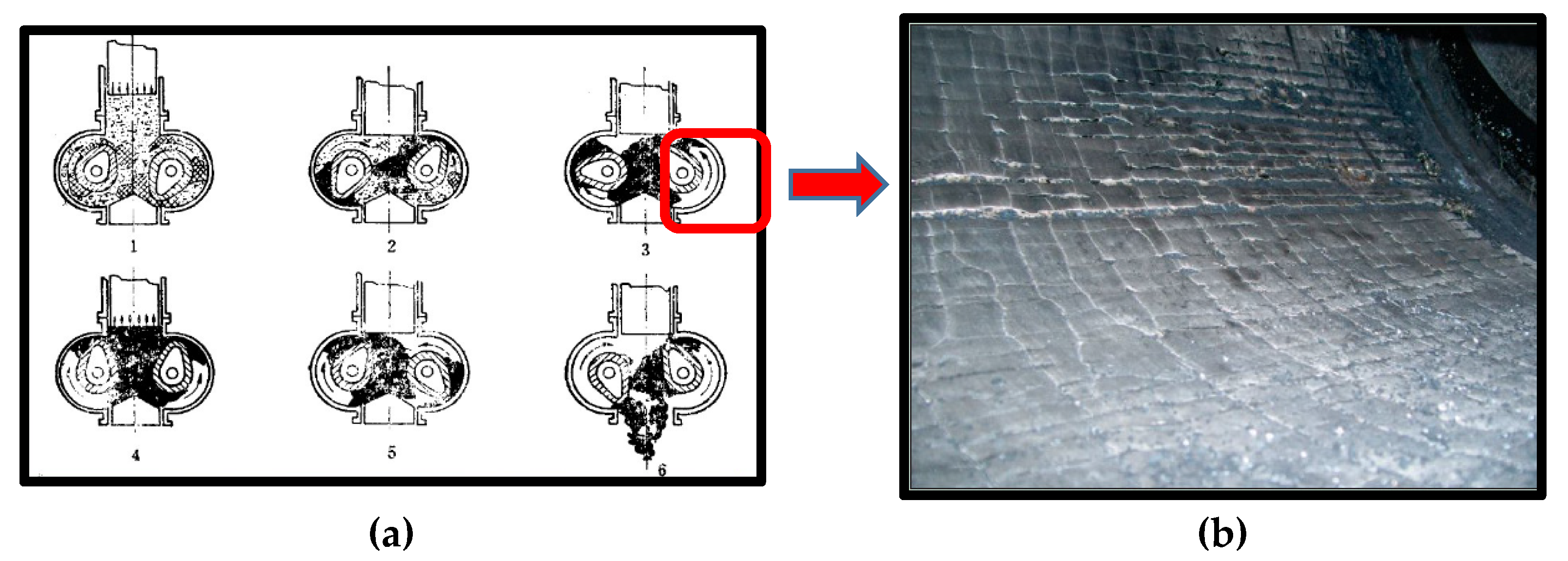
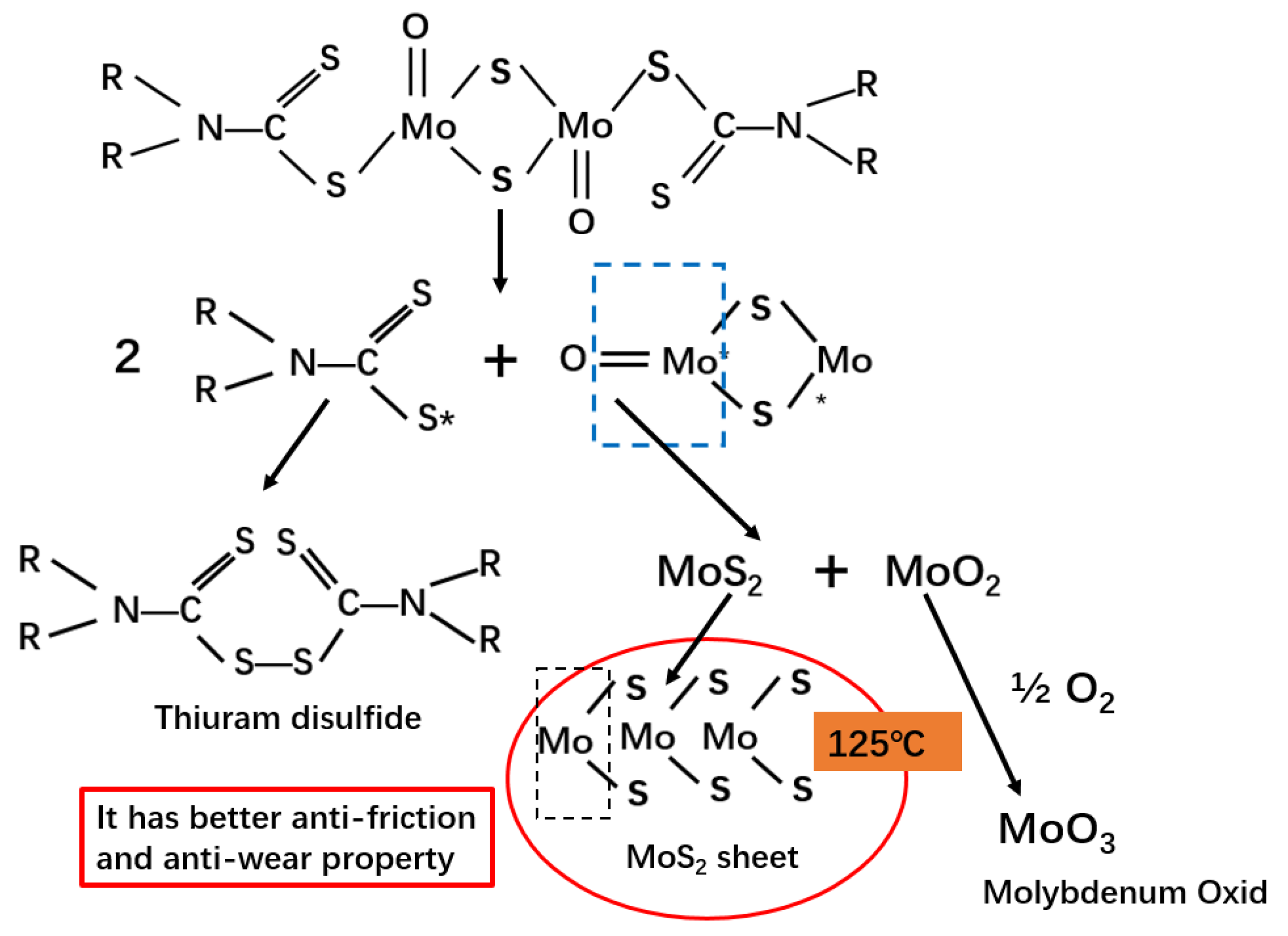

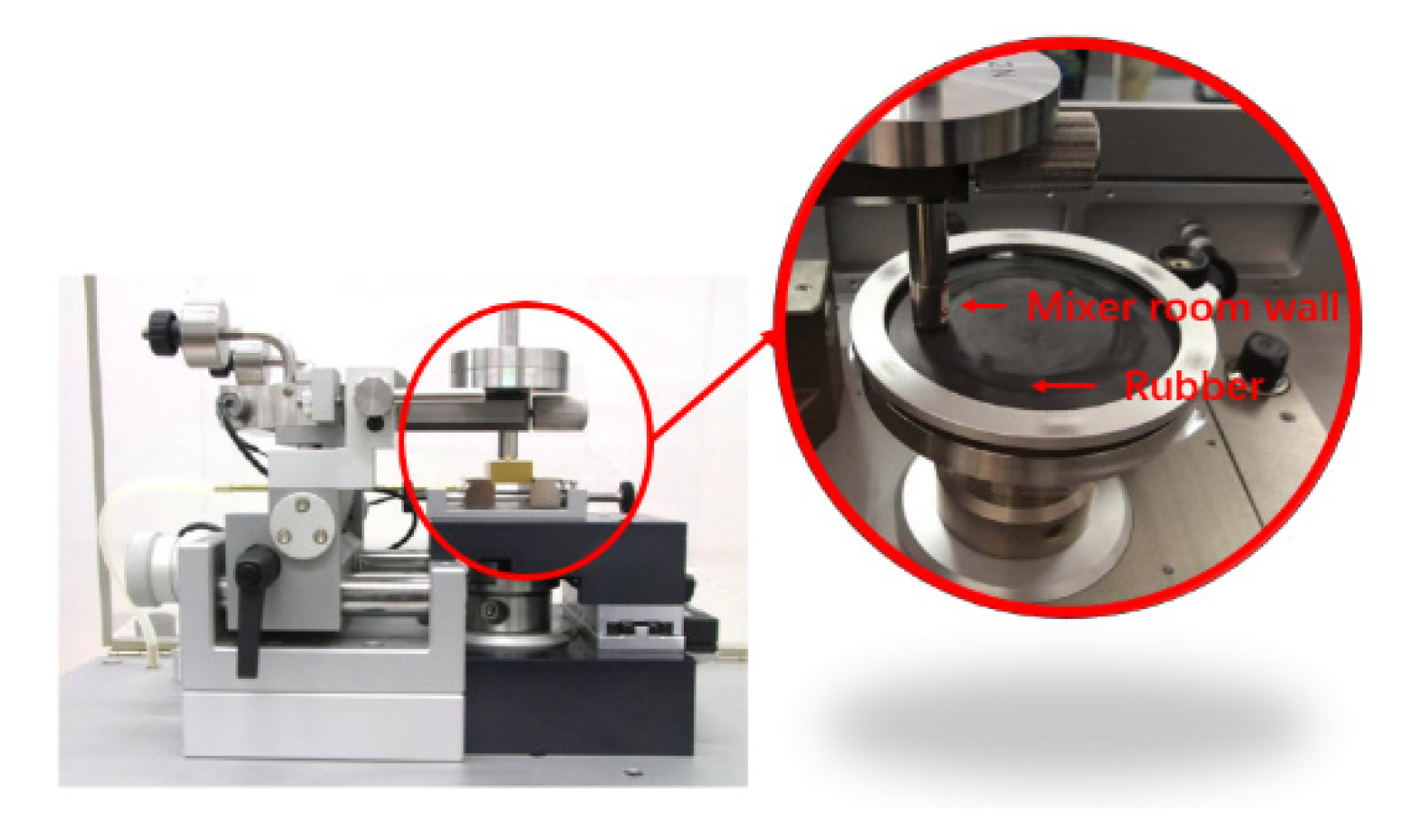

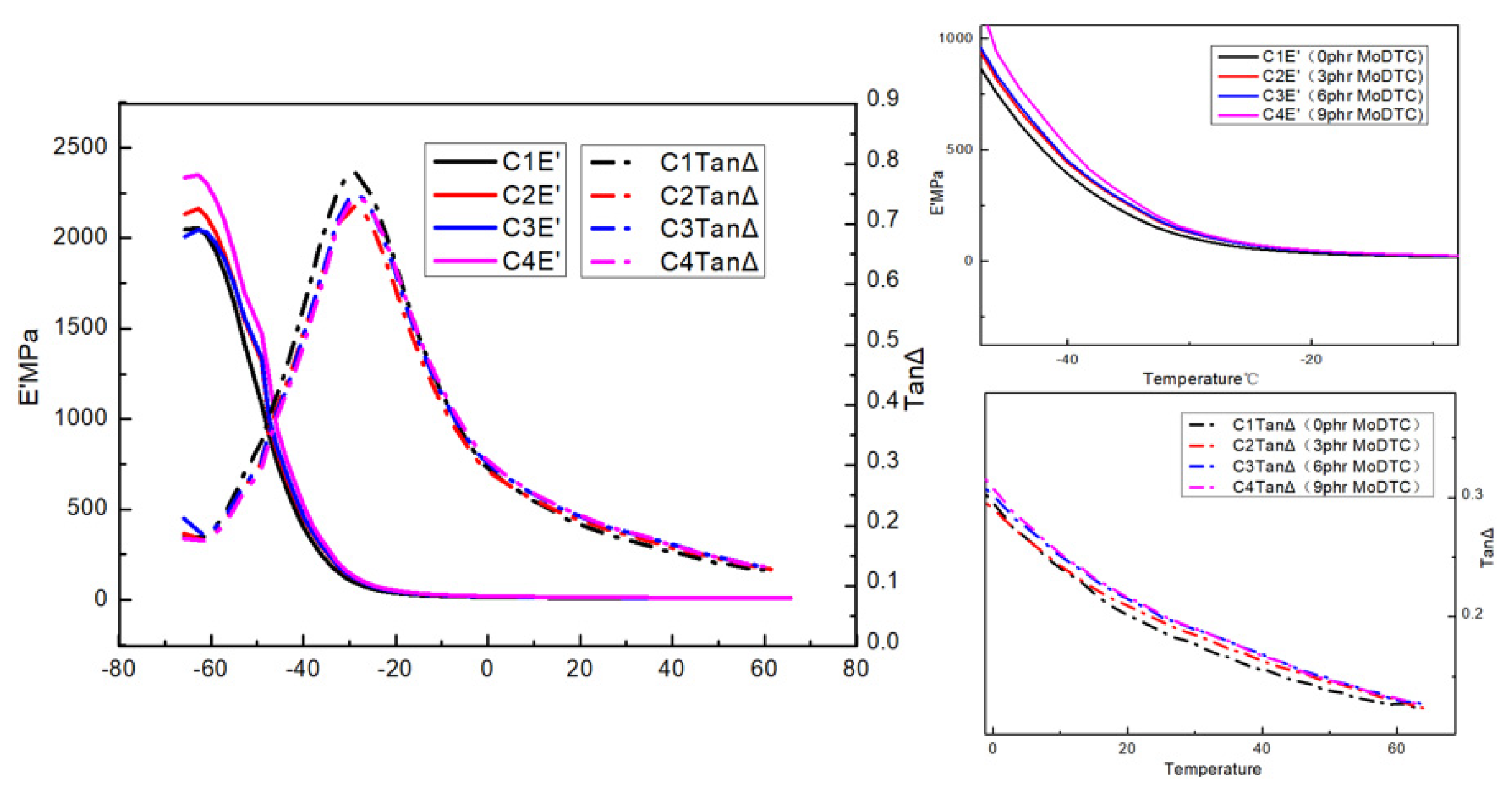

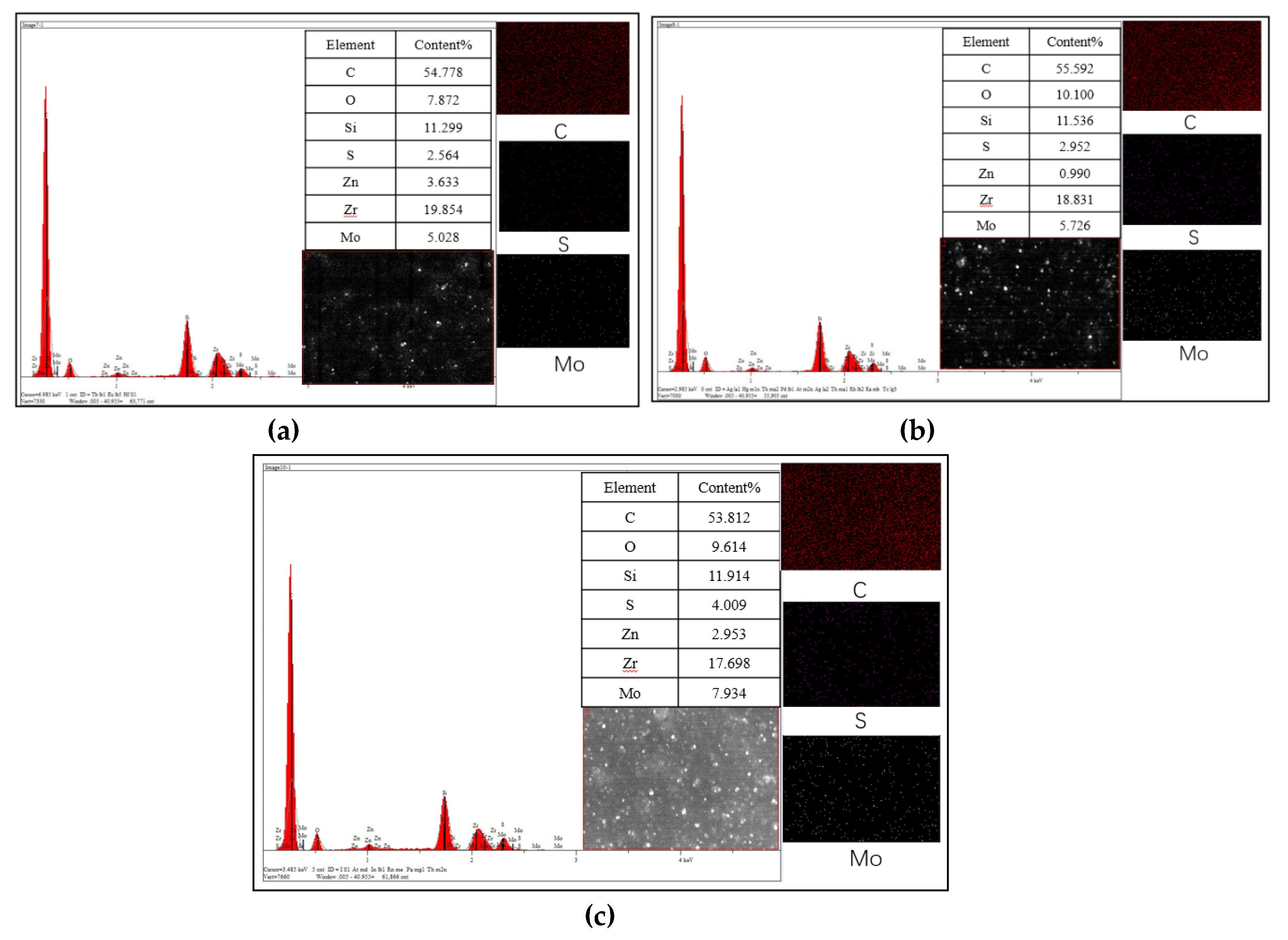
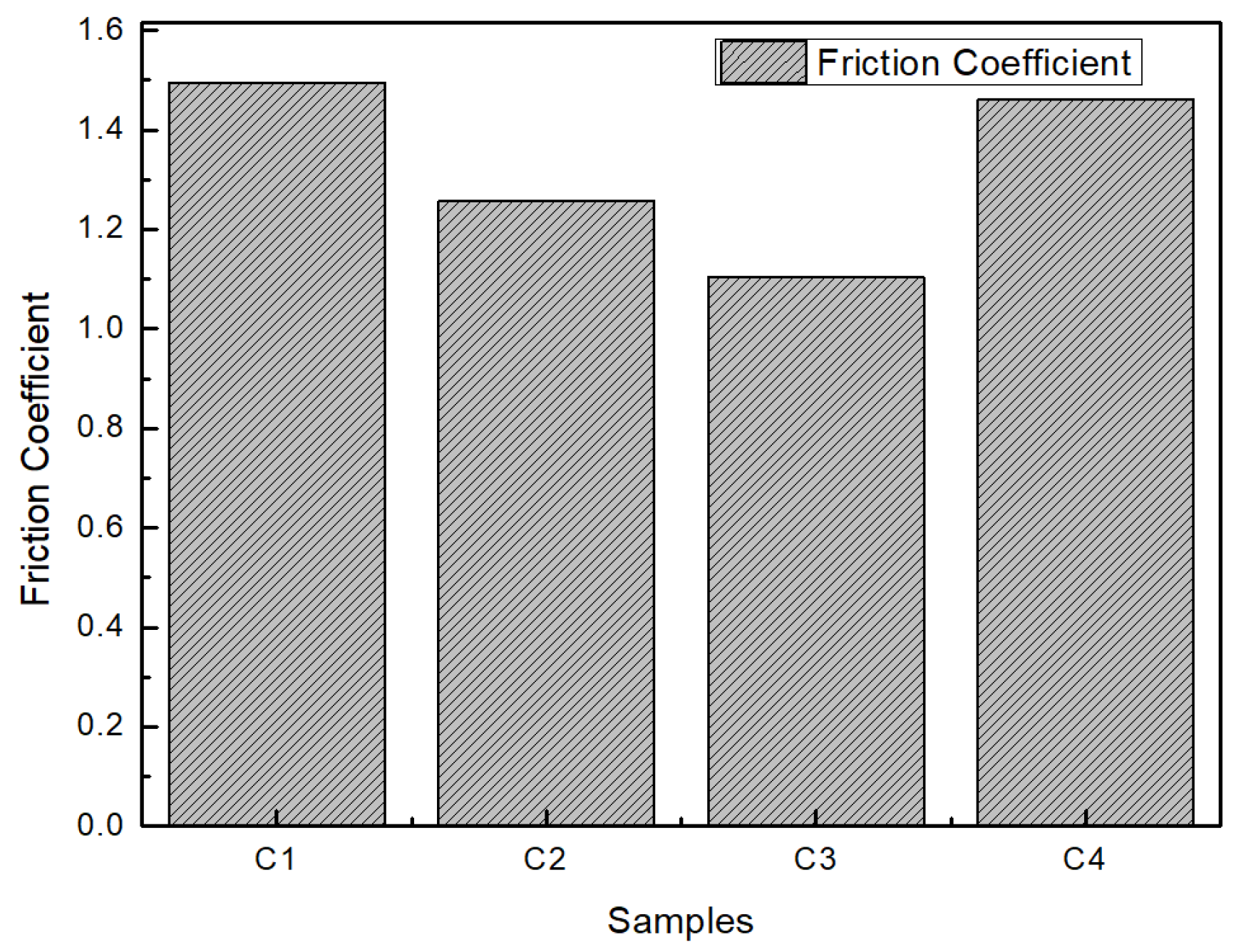


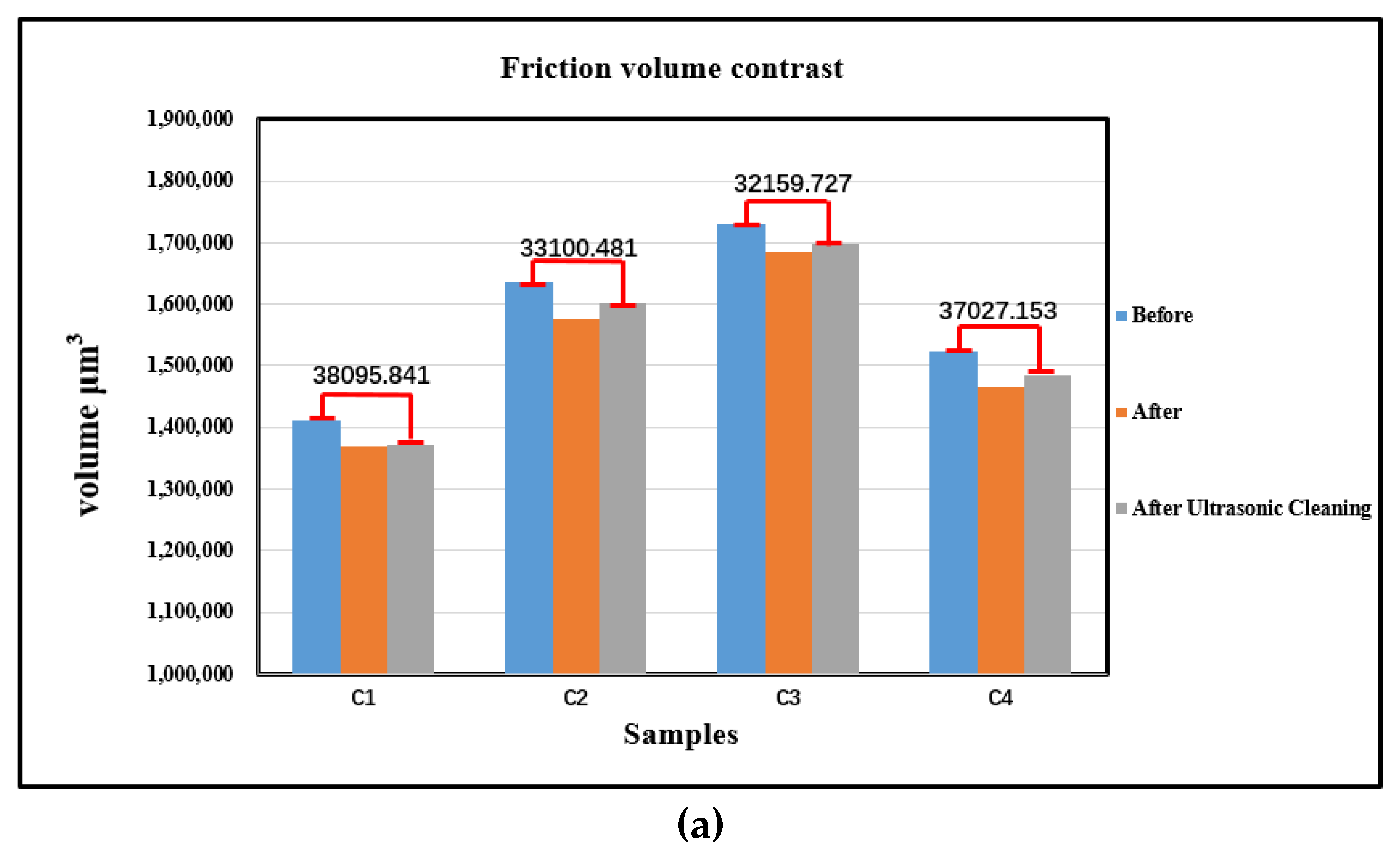

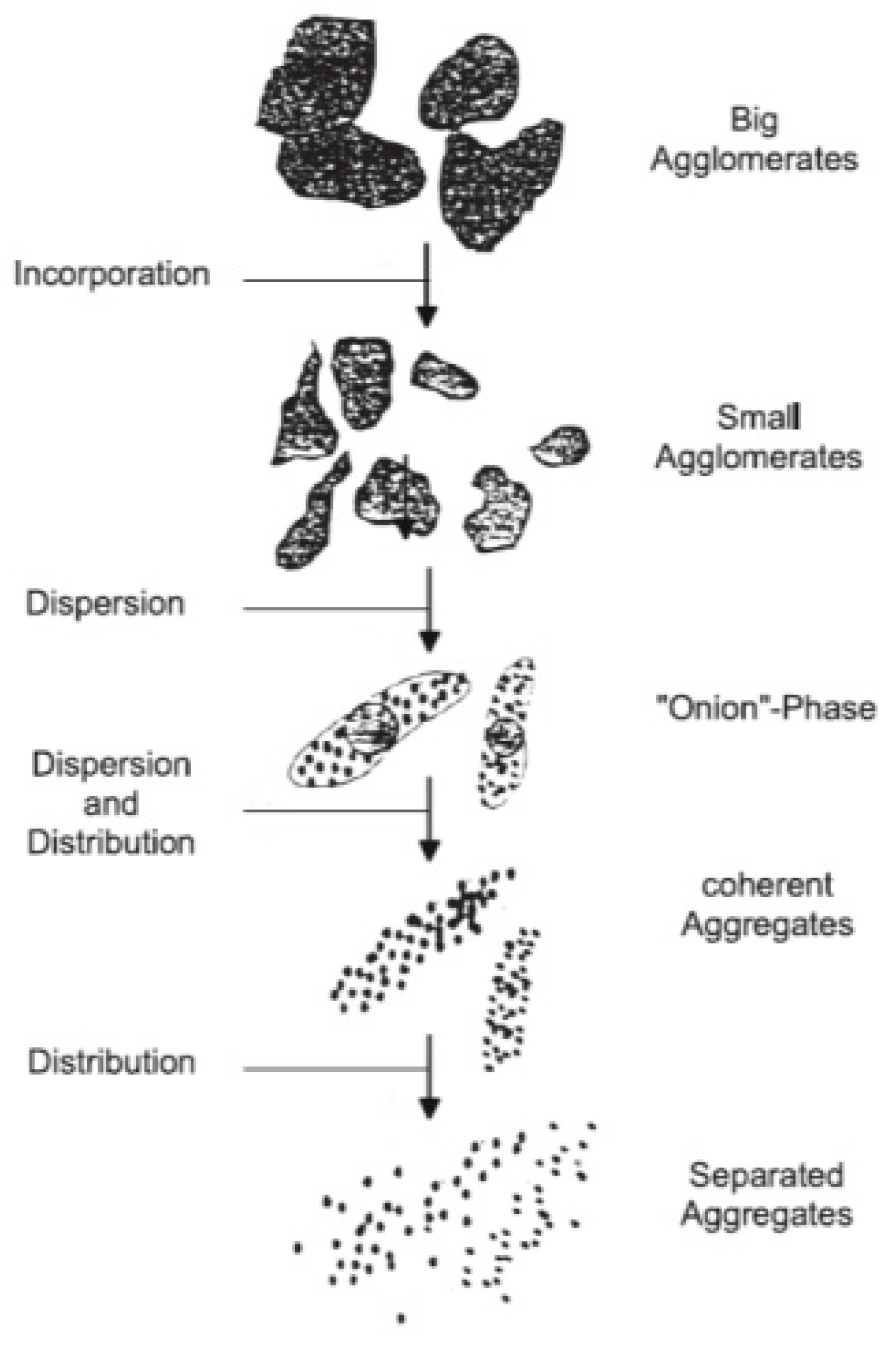
| Raw Material | C1 | C2 | C3 | C4 |
|---|---|---|---|---|
| BR9000 | 25.5 | 25.5 | 25.5 | 25.5 |
| RC2557S | 81.81 | 81.81 | 81.81 | 81.81 |
| TSR20 | 15 | 15 | 15 | 15 |
| N234 | 60 | 60 | 60 | 60 |
| Silica115MP | 10 | 10 | 10 | 10 |
| Si69mix | 1.2 | 1.2 | 1.2 | 1.2 |
| DPG | 0.18 | 0.18 | 0.18 | 0.18 |
| MODTC | 0 | 3 | 6 | 9 |
| S | 1.3 | 1.3 | 1.3 | 1.3 |
| CZ | 1.8 | 1.8 | 1.8 | 1.8 |
| Others | Protection system: 3.5 phr; activation system: 4 phr | |||
| 1.6 L Hake Mixer, 80 rpm, 75% FF ( Fill Factor) | ||
|---|---|---|
| Time | T (°C) | Ingredients |
| Master batch | ||
| 0: 00 | 70 | Polymers |
| 0: 40 | - | Chemical, carbon black |
| 1: 10 | - | Carbon black |
| 2: 30 | 120 | Sweep |
| 4: 00 | 135 | Sweep, sampling |
| 5: 00 | 145 | Discharge |
| Final mix (divided into two parts) | ||
| Part 1: Put into a pressure plate container for friction and wear test | ||
| Part 2: Curing system was added for performance testing | ||
| Test List | C1 | C2 | C3 | C4 |
|---|---|---|---|---|
| MH (N m) | 18.78 | 19.64 | 19.60 | 19.65 |
| ML (N m) | 2.5 | 2.93 | 2.97 | 3.05 |
| MH–ML (N m) | 16.28 | 16.71 | 16.23 | 16.6 |
| tc10 (min) | 3.75 | 3.37 | 3.61 | 3.45 |
| tc50 (min) | 7.58 | 4.62 | 5.02 | 4.69 |
| tc90 (min) | 14.47 | 8.97 | 8.83 | 8.26 |
| Test List | C1 | C2 | C3 | C4 |
|---|---|---|---|---|
| Hardness (ShoreA) | 60.5 | 63.5 | 61 | 62.5 |
| 10% Tensile Modulus (MPa) | 0.58 | 0.57 | 0.49 | 0.51 |
| 50% Tensile Modulus (MPa) | 1.19 | 1.37 | 1.23 | 1.30 |
| 100% Tensile Modulus (MPa) | 1.76 | 2.12 | 1.86 | 1.96 |
| 300% Tensile Modulus (MPa) | 6.65 | 8.42 | 7.42 | 7.76 |
| Tensile Strength (MPa) | 15.71 | 15.14 | 15.27 | 14.75 |
| Elongation at Break (%) | 574.05 | 467.78 | 510.06 | 474.18 |
| Rubber abrasion (%) | 6% | 7% | 8% | 8% |
| DMA | C1 | C2 | C3 | C4 |
|---|---|---|---|---|
| Tg | −28.68 | −28.7164 | −28.687 | −28.7105 |
| 0 °C tanδ | 0.2954 | 0.2900 | 0.30008 | 0.3078 |
| −20 to 20 °C tanδ | 14.2586 | 13.87645 | 14.4058 | 14.64935 |
| 40 °C tanδ | 0.1555 | 0.1631 | 0.16797 | 0.1675 |
| 60 °C tanδ | 0.1266 | 0.1300 | 0.12967 | 0.1314 |
© 2020 by the authors. Licensee MDPI, Basel, Switzerland. This article is an open access article distributed under the terms and conditions of the Creative Commons Attribution (CC BY) license (http://creativecommons.org/licenses/by/4.0/).
Share and Cite
Pan, Y.; Han, D.; Zhu, L.; Zhang, M.; Bian, H.; Wang, C.; Han, W. Effect of Adding MoDTC on the Properties of Carbon Black Rubber and the Friction and Wear of Metal during Mixing Process. Materials 2020, 13, 1071. https://doi.org/10.3390/ma13051071
Pan Y, Han D, Zhu L, Zhang M, Bian H, Wang C, Han W. Effect of Adding MoDTC on the Properties of Carbon Black Rubber and the Friction and Wear of Metal during Mixing Process. Materials. 2020; 13(5):1071. https://doi.org/10.3390/ma13051071
Chicago/Turabian StylePan, Yiren, Deshang Han, Lin Zhu, Meng Zhang, Huiguang Bian, Chuansheng Wang, and Wenwen Han. 2020. "Effect of Adding MoDTC on the Properties of Carbon Black Rubber and the Friction and Wear of Metal during Mixing Process" Materials 13, no. 5: 1071. https://doi.org/10.3390/ma13051071





